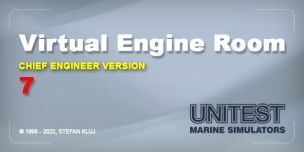 Virtual Engine Room 7 includes:
Virtual Engine Room 7 includes:
- Main engine (2 stroke, low speed, 7 cylinders, fixed pitch propeller)
- Two complete main engine models: a conventional with a camshaft and electronically controlled
- Main engine remote control system (manual from CR, automated from the bridge and the emergency control at the engine side)
- Fuel system (MDO, HFO and Low Sulphur Fuel, including storage system and separators).
- Lubricating system (LO circulation and separator, LO storage and stern tube lubricating).
- Cooling system (sea water and fresh water central cooling).
- Compressed air system.
- Sewage treatment plant.
- Sludge and garbage incinerator.
- Steam system (auxiliary boiler, waste heat recovery, superheated steam, consumers).
- Power plant (2 diesel generators, 1 shaft generator, 1 turbo generator and 1 emergency diesel generator, multiple power consumers with separate circuits and bow thruster).
- Bilge system with oily water separator.
- Ballast system.
- Steering gear.
- Refrigerating system.
- Domestic water system
- Air conditioning system
- Simplified own ship model with ship speed modelling.
- Engine room ventilation system.
- Inert gas system.
- Turbo pump.
- Engine room ventilation system.
- Water mist firefighting system.
- CO2 firefighting system.
- PID controllers
- ECO Module.
- Emission Module.
- Diagnostic Expert.
- ME Maintenance.
Here is a list of VER7 main features when compared to the well-known VER6 simulator:
- Permanent emission monitoring (EEXI, NOx and SOx) and its comparison with MARPOL requirements.
- Possibility to simulate 30 different ME faults, where their requested values can be selected freely from the given range.
- Random selection of the ME faults.
- Diagnostic Expert with an advice which ME maintenance or a control system setting is recommended in the present technical state of ME.
- Availability of 23 different maintenance actions which can be used in order to fix the present ME technical problems.
- Possibility to observe the influence of the ME technical state on the ME emission and the compliance with MARPOL requirements.
